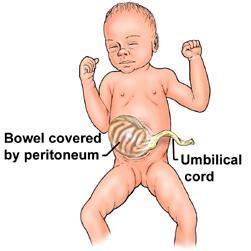
An omphalocele is a birth defect where abdominal organs protrude from the belly and lie exposed outside the abdomen. The organs, usually the intestines and liver, are covered in a thin sac. Associated abnormalities can include a smaller-than-normal abdominal cavity or lungs, organ damage or infection (especially if the sac holding the intestines ruptures).
The abdominal wall with an omphalocele fails to develop properly, leaving the abdominal contents covered by a thin membrane. The size and severity of this condition ranges from small, with only part of the intestines protruding, to large, with entire and multiple organs remaining outside of the abdomen.
The incidence of omphalocele ranges from approximately 1 in 4,000 to 1 in 7,000 live births. There is an increased risk of stillbirth in babies with this condition, which is why we strive for early diagnosis and observation.
What causes it?
The defect is thought to be caused by an abnormality that occurs during the process of body infolding in the embryo at 3 to 4 weeks of pregnancy. While no specific cause is known, omphalocele has been associated with advanced maternal age.Studies also show that several factors can increase the likelihood of having a baby with omphalocele. Women who are obese or overweight prior to pregnancy are more likely to have a baby with omphalocele, as are women who drink alcohol, smoke cigarettes or take certain kinds of anti-depressants during pregnancy.
Diagnosis
Omphalocele is often detected from a routine prenatal ultrasound. The condition can also trigger abnormal results on prenatal blood screening tests.
Treatment Options
Omphalocele treatment plans depend on the number of organs involved and how much of those organs remain outside of the belly at birth. If only parts of the intestines are protruding, surgeons return them to the abdomen soon after birth and close the opening in the abdominal wall. If the omphalocele is large with multiple organs exposed, or there are associated respiratory problems, physicians usually take a phased approach. In the most severe cases, doctors will take time to allow the body to grow skin over the membrane. Ace wraps can then be used to develop space to accommodate the organs, with repair of the defect occurring at 1-2 years of age. Currently, there are no fetal (in utero) interventions offered to treat omphalocele.
Read patient stories:
Charlotte: Surviving a Fetal Omphalocele and Finding Silver Linings
Giant Omphalocele: Patient born with organs outside of her abdomen receives transformative care
*diagnostic information provided courtesy of our partners at Colorado Fetal Care Center
The Fetal Health Foundation is a parent-founded non profit helping families experiencing a fetal syndrome diagnosis.
